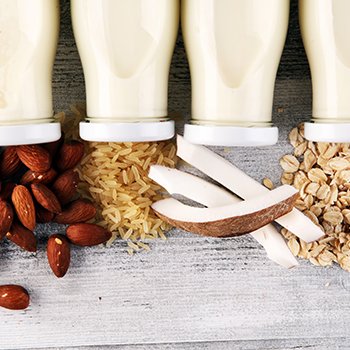ผลิตภัณฑ์นมกับนมจากพืช กับมุมมองของความเหมือนที่แตกต่าง Dairy and Plant-based Milk Products with Similar Aspects But Different Points
1043 Views |

By: ดร. ปาริฉัตร หงสประภาส
Parichat Hongsprabhas, Ph.D.
Founder and CTO
FoodInnovate and BTLLAgroforestry
foodinnovateall@gmail.com
นมเป็นอาหารสำคัญสำหรับโภชนาการของมนุษย์เนื่องจากมีสารอาหารมากมาย และหลายประเทศยังแนะนำให้มีการบริโภคนมเป็นประจำ อย่างไรก็ตาม ตั้งแต่ปี พ.ศ. 2555 เป็นต้นมา การบริโภคนมจากสัตว์มีแนวโน้มลดลง สาเหตุหลักเนื่องจากผู้บริโภคบางกลุ่มแพ้แลคโตสและโปรตีนจากนมวัว นอกจากนั้น ผู้บริโภคยังมีความกังวลเกี่ยวกับการใช้ยาปฏิชีวนะในสัตว์ที่อาจส่งผ่านมาทางน้ำนม จึงส่งผลให้ผู้บริโภคมีความต้องการผลิตภัณฑ์นมทางเลือกมากขึ้น ดังนั้น เทรนด์ของอุตสาหกรรมอาหารและเครื่องดื่มในปี พ.ศ. 2567 จึงมุ่งเน้นผลิตภัณฑ์ที่ช่วยให้ผู้บริโภคมีชีวิตที่ยืนยาวและมีสุขภาพที่ดี รวมถึงมีรสชาติอร่อยและคุ้มค่ากับราคาที่ผู้บริโภคสามารถจ่ายได้
ผลิตภัณฑ์นมมีอะไรบ้าง
หลายคนรู้จักผลิตภัณฑ์นมในรูปของนมพร้อมดื่มไขมันเต็ม นมพร่องไขมัน และนมขาดไขมัน รวมทั้งโยเกิร์ต เนยแข็ง ครีม เนย และไอศกรีม ซึ่งผลิตภัณฑ์เหล่านี้อาจผลิตมาจากน้ำนมดิบโดยตรง หรือเกิดจากกระบวนการแยกส่วน เช่น การผลิตหางนม (skim milk) โดยการแยกครีม (cream) ออก หรือการผลิตโปรตีนเวย์เข้มข้น (whey protein concentrate) และโปรตีนเวย์ไอโซเลท (whey protein isolate) จากน้ำเวย์ที่เหลือจากการทำเนยแข็งหรือการตกตะกอนเคซีน และการผลิตน้ำตาลแลคโตสจากบัตเตอร์มิลค์ (butter milk) ซึ่งเป็นผลพลอยได้จากการผลิตเนยจากครีม
นอกจากนี้ ยังสามารถนำส่วนประกอบของน้ำนมมาคืนรูปเป็นนมพร้อมดื่ม (recombined milk) และบางครั้งอาจเติมโปรตีนหรือแคลเซียมเพิ่มจากน้ำนมโคปกติ เพื่อให้ผลิตภัณฑ์นมนั้นเป็นแหล่งของสารอาหารที่ดี หรือบางครั้งอาจทำให้ผลิตภัณฑ์มีน้ำตาลแลคโตสลดลง หรือปราศจากน้ำตาลแลคโตสเพื่อตอบสนองความต้องการของผู้บริโภค
เหตุใดผลิตภัณฑ์นมจึงมีลักษณะที่แตกต่างกัน
ความแตกต่างของผลิตภัณฑ์นมแต่ละชนิดเกิดจากการควบคุมคุณสมบัติของโปรตีนนมและไขมันนมในระหว่างการแปรรูปเป็นผลิตภัณฑ์ต่างๆ โปรตีนนมในน้ำนมโคมีอยู่ประมาณร้อยละ 2.3-4.4 โดยน้ำหนัก ซึ่งมีโปรตีนเคซีนเป็นโปรตีนหลักแขวนลอยอยู่ในน้ำนมในรูปของเคซีนไมเซลล์ (casein micelle) ซึ่งเป็นฟอสโฟโปรตีน (phosphoprotein) และสามารถเชื่อมข้ามระหว่างโมเลกุลด้วยแคลเซียมไอออนและรักษาโครงสร้างจตุรภูมิของเคซีนไมเซลล์ ในขณะที่โปรตีนนมอีกกลุ่มหนึ่ง คือ โปรตีนเวย์ซึ่งละลายในส่วนของซีรัมได้ในช่วง pH 4 – 6 สำหรับการผลิตโยเกิร์ตและเนยแข็ง เป็นการทำให้โปรตีนนมเกิดการจับตัวเป็นก้อน (coagulation) หรือเกิดโครงข่ายร่างแหสามมิติ (three-dimensional network) โดยการปรับค่าความเป็นกรด-ด่าง หรือการใช้เอนไซม์เรนเนต
Milk is an integral part of human nutrition. It contains a wide range of nutrients and is an essential part of nutritional recommendations in many countries. However, since 2012, the consumption of animal milk has been on a downward trend. Significant concerns arise from lactose intolerance and cow's milk protein allergies. Additionally, consumers are wary of using antibiotics in animals that may be passed on to milk. As a result, consumers are demanding alternative products. Food and beverage industry trends for 2024 thus focus on products that help consumers live a long and healthy life and are delicious, tasty, and cost-effective, with prices within the reach of consumers.
What are dairy products?
Many of us know dairy products in full-fat drinking milk, low-fat milk, skimmed milk, yoghurt, cheese, cream, butter, and ice cream. These products may be produced directly from raw milk or by separation processes such as the production of skimmed milk by separating the cream, the production of whey protein concentrate and whey protein isolate from whey remaining from cheese making or casein precipitation, and the production of lactose from buttermilk, which is a by-product of butter churning from cream.
In addition to that, we can also reconstitute milk components into drinking milk products, i.e., recombined milk. Sometimes, additional protein or calcium may be supplemented with regular cow's milk to make the milk product a good source of nutrients. Milk products also include lactose-free products to meet the needs of consumers.
Why do these dairy products look different?
The differences between milk products are due to the ability to control the properties of milk proteins and fats during processing into different outcomes. Milk protein in cow's milk is approximately 2.3-4.4% by weight, with casein being the main protein as casein micelles. Casein micelles are composed of phosphoproteins and can cross-link among molecules with calcium ions and maintain the quaternary structure of casein micelles. Another group of milk proteins is whey proteins, which can dissolve in the serum over a wide range of pH. In the production of yoghurt and cheese, milk proteins coagulate or form a three-dimensional network by adjusting the pH or using the enzyme rennet to coagulate casein micelles.






